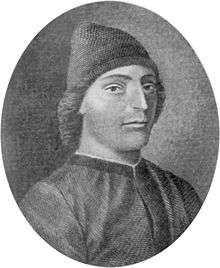Guarino da Verona
Guarino Veronese or Guarino da Verona (1374 – December 14, 1460) was an early figure in the Italian Renaissance.
Guarino | |
|---|---|
 Guarino da Verona | |
| Born | 1374 |
| Died | December 14, 1460 (aged 86) |
| Occupation | Italian translator |
Biography

He was born in Verona, Italy, and later studied Greek at Constantinople, where for five years he was the pupil of Manuel Chrysoloras. He was also a student of John of Ravenna.[1]
When he set out to return home, he had with him two cases of precious Greek manuscripts which he had taken great pains to collect. It is said that the loss of one of these by shipwreck caused him such distress that his hair turned grey in a single night. On arriving back in Italy, he earned a living as a teacher of Greek, first in Verona and afterwards in Venice and Florence. In 1436, he became a professor of Greek at Ferrara through the patronage of Leonello, the marquis of Este. His method of instruction was renowned and it attracted many students from Italy and the rest of Europe as distant as England. Many of them, notably Vittorino da Feltre, afterwards became well-known scholars and, as Vittorino would later, he would support poor students from his own funds. From 1438 on he interpreted for the Greeks at the councils of Ferrara and Florence. He was particularly influenced by the philosopher Gemistus Pletho. He died at Ferrara in 1460.
His principal works are translations of Strabo and of some of the Lives of Plutarch, a compendium of the Greek grammar of Chrysoloras, and a series of commentaries on Persius, Martial, the Satires of Juvenal, and on some of the writings of Aristotle and Cicero. The layout of the Studiolo of the Palazzo Belfiore is also attributed to him.
He corresponded with the writer and humanist Isotta Nogarola.[2]
References
-

- "Isotta_Nogarola". Society_for_the_Study_of_Women_Philosophers. Retrieved 2019-04-26.
Sources

- Guarino da Verona at the Mathematics Genealogy Project
- Guarino da Verona from Catholic Encyclopedia
- Guarino da Verona in Ferrara
- Marsh, D. (1998). Lucian and the Latins: Humor and Humanism in the Early Renaissance. University of Michigan Press. p. 21. ISBN 9780472108466. Retrieved 2015-11-03.
- Durant, Will. (1953). The Renaissance. The Story of Civilization. 5. New York: Simon & Schuster. p. 269.
- Omont, Henri: Portrait de Guarino de Veronese, Bulletin de la Societé Nationale des Antiquaires de France, 1904, 323–326. https://archive.org/stream/bulletin1904sociuoft#page/n339/mode/2up (Book mentioned in this article, there is today: University of Minnesota, James Ford Bell Library, ms. 1460/f St.)
| Wikimedia Commons has media related to Guarino da Verona. |